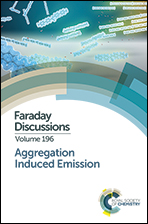Cellular membrane-anchored fluorescent probe with aggregation-induced emission characteristics for selective detection of Cu2+ ions
Abstract
The exploration of advanced fluorescent probes that can detect divalent copper (Cu2+) in aqueous environments and even in live organisms is particularly valuable for understanding the occurrence and development of Cu2+-related diseases. In this work, we report the design and synthesis of an aggregation-induced emission luminogen (AIEgen)-based probe (TPE-Py-EEGTIGYG) by integrating an AIEgen, TPE-Py, with a peptide, EEGTIGYG, which can selectively detect Cu2+ in both aqueous solution and live cells. Peptide EEGTIGYG has dual functionality in the probe design, namely improving water solubility and providing specific cell membrane-binding ability. TPE-Py-EEGTIGYG can self-assemble into nanoaggregates at high concentration in aqueous solution (e.g., 25 μM), which possess large fluorescence output due to the restriction of intramolecular rotation of the phenyl rings on TPE-Py. The fluorescence of the TPE-Py-EEGTIGYG nanoaggregates can be significantly quenched by Cu2+ but not by other metal ions, achieving the selective detection of Cu2+ in aqueous media. Furthermore, TPE-Py-EEGTIGYG can exist as a molecular species and is very weakly fluorescent in dilute aqueous solution (e.g., 5 μM), but can however largely switch on its fluorescence upon specifically anchoring onto the cell membrane. The emissive probes on the cell membrane can be used for the detection of Cu2+ ions that move in and out of cells with a fluorescence “turn-off” mode.
- This article is part of the themed collection: Aggregation Induced Emission

 Please wait while we load your content...
Please wait while we load your content...